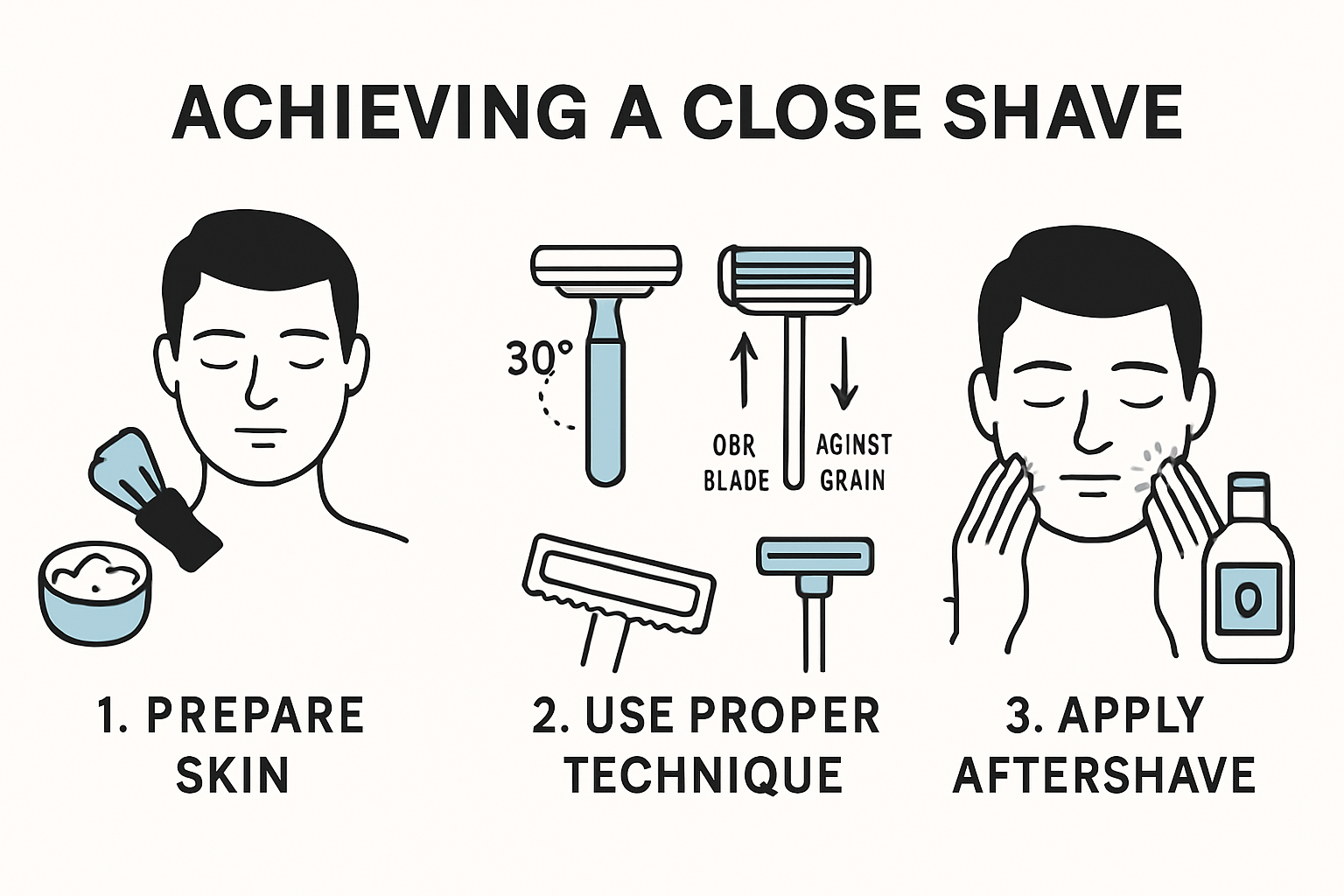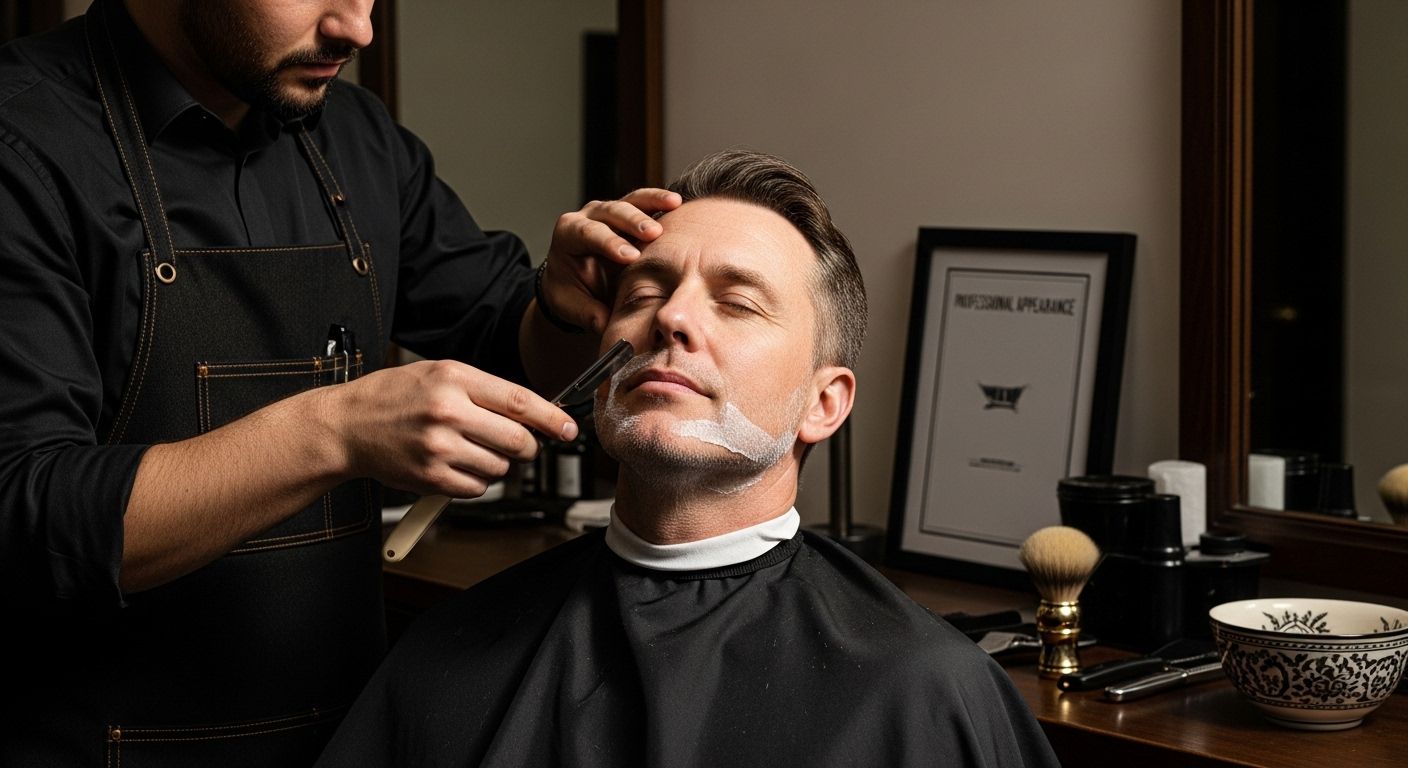A close shave goes far beyond removing facial hair and it is recognized as an art form rooted in skill and careful technique. Now check this out. A true close shave means zero visible stubble and almost glass-smooth skin which most people think is impossible outside a barbershop. But the real secret is that anyone can master it at home with the right tools and a bit of knowledge and this changes everything about how you look and feel.Quick Summary
| Takeaway | Explanation |
|---|---|
| A close shave demands precision techniques. | Achieving minimal stubble requires skillful techniques tailored to hair growth patterns and skin types. |
| Invest in quality shaving tools. | High-quality razors and grooming products enhance shaving efficiency and comfort while reducing skin irritation. |
| Grooming affects self-confidence and perception. | A precise shave boosts confidence, helps project professionalism, and influences how others perceive you in social and work settings. |
| Understand common shaving myths. | Shaving does not change hair thickness; awareness of myths helps improve shaving approaches and outcomes. |
| Mastering shaving is a valuable life skill. | Practicing the art of shaving elevates daily grooming into a personal care ritual that reflects self-respect and attention to detail. |
Defining a Close Shave: Concept and Importance
A close shave represents more than just hair removal – it’s a precision grooming technique that aims to cut hair as close to the skin’s surface as possible, creating an ultra-smooth, clean appearance. Understanding what constitutes a close shave involves recognizing the nuanced skill and technique required to achieve optimal results.

The Technical Definition of a Close Shave
At its core, a close shave means removing facial or body hair with minimal stubble remaining, creating an extremely smooth skin surface. Unlike casual shaving, which might leave noticeable hair remnants, a truly close shave involves carefully cutting hair at or just below the skin’s surface. According to Dermatology Online Journal, this precision requires specialized techniques and understanding of hair growth patterns, skin type, and appropriate shaving tools.
Key characteristics of a close shave include:
- Minimal visible hair stubble after shaving
- Smooth skin texture without irritation
- Consistent hair removal across different facial contours
- Reduced likelihood of ingrown hairs
Below is a table summarizing the key characteristics that define a close shave. Use this table to quickly identify what sets a true close shave apart from a casual shave.
| Characteristic | Description |
|---|---|
| Minimal visible hair stubble | Almost zero hair left after shaving |
| Smooth skin texture | Skin feels soft and glass-like with no rough patches |
| Low irritation | No redness, bumps, or discomfort after shaving |
| Consistent hair removal | Even results across all areas and facial contours |
| Reduced ingrown hairs | Less likelihood of hairs curling back into the skin |
Why Precision Matters in Shaving
Precision in shaving goes beyond aesthetic appeal. A close shave impacts personal confidence, professional appearance, and skin health. Men who master the close shave technique understand that it’s not just about removing hair, but about creating a refined, well-groomed look.
The historical context of shaving reveals its deeper significance. Smithsonian Institution research indicates that hair removal practices evolved from hygiene necessities to sophisticated personal grooming rituals. Today, a close shave represents personal care, attention to detail, and a commitment to maintaining a polished appearance.
Achieving a consistently close shave requires understanding individual skin characteristics, investing in quality tools, and developing proper technique. It’s a skill that combines technical knowledge with personal touch, transforming a daily routine into an art form of personal presentation.
The Science Behind a Close Shave: Tools and Techniques
The pursuit of a perfect close shave is a sophisticated interplay of scientific principles, engineering precision, and personal technique. Understanding the underlying mechanics transforms shaving from a mundane task into a refined grooming art.
Razor Blade Engineering and Hair Interaction
Razor blade design represents a complex technological challenge. MIT researchers have demonstrated that razor blades interact with hair through microscopic mechanisms that determine cutting efficiency. The blade’s material composition, edge angle, and surface treatment directly influence its ability to slice hair cleanly and smoothly.
Key engineering considerations in razor blade design include:
- Blade metallurgy and hardness
- Precision edge geometry
- Surface friction characteristics
- Metallurgical treatments for edge retention
Skin Dynamics and Hair Removal Mechanics
A close shave involves intricate interactions between the razor, hair, and skin surface. Optimal hair removal requires understanding hair growth patterns, skin topology, and the biomechanical properties of hair follicles. Different skin types and hair textures demand nuanced approaches to achieve a consistently smooth result.
The physiological response of skin during shaving involves complex biochemical processes. Proper technique minimizes irritation by reducing mechanical stress and maintaining skin barrier integrity. National Library of Medicine research indicates that factors like hydration, blade sharpness, and shaving angle significantly impact skin health during hair removal.
Professional groomers understand that a close shave is not just about removing hair, but about preserving skin integrity. By combining scientific understanding with precision tools, men can transform their daily grooming routine into a sophisticated ritual of personal care. For those seeking premium shaving solutions, understanding these scientific principles becomes key to achieving consistently exceptional results.
Benefits of a Close Shave: Personal Grooming and Confidence
A close shave transcends mere hair removal, representing a profound personal transformation that impacts psychological well-being, professional perception, and individual self-image. Understanding its multifaceted benefits reveals how this grooming practice contributes to personal empowerment and social dynamics.
Psychological Impact of Personal Grooming
Grooming is fundamentally linked to self-perception and mental wellness. Associated Barber College research demonstrates that personal care routines significantly influence psychological states. A meticulously executed close shave signals attention to detail, self-respect, and a commitment to personal presentation.
Key psychological benefits include:
- Enhanced self-confidence
- Improved professional perception
- Increased sense of personal control
- Reduced anxiety about physical appearance
Professional and Social Implications
In professional environments, personal appearance communicates volumes about an individual’s discipline, professionalism, and self-management. A precise, close shave suggests meticulousness, suggesting to colleagues and potential employers that one approaches tasks with similar precision and care. The subtle messaging of a well-groomed appearance can influence career opportunities and interpersonal interactions.
Beyond professional contexts, personal grooming impacts social dynamics. A polished appearance signals self-awareness, respect for social conventions, and personal pride. Our comprehensive guide on professional grooming offers deeper insights into these nuanced social interactions.

Ultimately, a close shave represents more than a physical transformation. It’s a deliberate act of self-care that communicates confidence, professionalism, and personal standards. By investing time and attention in this daily ritual, men can cultivate a powerful narrative of self-respect and intentional personal presentation.
Common Misconceptions about Close Shaves: Debunking Myths
The world of personal grooming is rife with persistent myths and misconceptions, particularly surrounding the art of achieving a close shave. Understanding the scientific reality behind these beliefs helps men make more informed decisions about their grooming routine.
Hair Growth and Shaving Myths
Clinical research from the National Institutes of Health definitively dispels one of the most prevalent myths: that shaving causes hair to grow back thicker or darker. In reality, shaving simply cuts hair at the surface, creating an optical illusion of increased thickness as the blunt-cut hair emerges.
Common misconceptions about hair growth include:
- Shaving makes hair grow back faster
- Shaved hair becomes coarser with repeated cutting
- Different areas of facial hair grow at identical rates
- Shaving fundamentally changes hair texture
This table outlines common myths about shaving and provides the science-backed truth behind each misconception. Refer to this table to clarify what shaving actually does to your hair.
| Shaving Myth | Reality |
|---|---|
| Shaving makes hair grow back thicker | Hair appears thicker because the blunt end feels stubbier |
| Shaved hair grows back faster | Shaving does not affect hair growth rate |
| Repeated shaving makes hair coarser | No change in hair texture from shaving |
| All parts of facial hair grow at the same rate | Hair growth rates differ by facial area |
The Science Behind Perceived Hair Changes
What appears to be changes in hair growth are actually natural biological phenomena. When hair is shaved, it grows back with a squared-off end, which can feel more stubby and appear darker. This sensation stems from the hair’s natural regrowth process, not any actual transformation caused by shaving.
Interestingly, genetic factors and hormones play a far more significant role in determining hair characteristics than shaving technique. Explore our comprehensive guide on understanding hair growth to gain deeper insights into these complex biological mechanisms.
Understanding these myths empowers men to approach shaving with scientific clarity, recognizing that proper technique, skin preparation, and quality tools matter far more than outdated folklore about hair growth and shaving.
The Evolution of Shaving: Trends and Innovations in Close Shaves
Shaving technology has undergone remarkable transformations, reflecting broader technological advancements and changing societal norms. From primitive sharp-edged tools to precision-engineered razors, the journey of close shaving represents a fascinating intersection of engineering, anthropology, and personal grooming.
Historical Technological Milestones
Smithsonian Institution research reveals that shaving tools have evolved dramatically over centuries. The introduction of the safety razor in the early 20th century marked a revolutionary moment, transforming shaving from a potentially dangerous ritual to an accessible daily practice. This innovation democratized personal grooming, making precise hair removal possible for millions.
Significant technological milestones include:
- Development of stainless steel blades
- Introduction of multi-blade cartridge systems
- Ergonomic handle designs
- Advanced metallurgical treatments for blade durability
Modern Engineering and Precision Innovations
Contemporary razor design represents a pinnacle of engineering sophistication. MIT researchers have extensively studied the microscopic interactions between razor blades and hair, revealing complex mechanical challenges in achieving the perfect close shave. Modern razors now incorporate advanced features like pivoting heads, lubricating strips, and precision-engineered blade angles.Learn more about our cutting-edge razor technology that continues pushing the boundaries of shaving precision. The future of close shaves promises even more intelligent design, focusing on minimizing skin irritation while maximizing hair removal efficiency.
Take Your Close Shave to the Next Level with SmartShave
If you have ever struggled to achieve that flawless smoothness described in our article on grooming precision, you know that choosing the right tools and technique is essential. Many men seek a stubble-free finish but battle with irritation, inconsistent results, or outdated razors that do not respect their skin. You deserve a grooming routine that matches your quest for confidence, personal care, and professional polish.
Discover how SmartShave.co.uk can redefine your daily shave. Our platform is designed for men who want science-backed shaving sets and replacement heads, delivered on their schedule. From pivoting heads to vitamin-enriched strips, our solutions help you master the close shave techniques outlined in our educational Uncategorized Archives. Join the thousands of men experiencing modern shaving with unbeatable comfort and control. Make your next shave your best yet—visit SmartShave.co.uk now and start your confidence upgrade today.
Frequently Asked Questions
What constitutes a close shave?
A close shave involves removing facial or body hair with minimal stubble remaining, resulting in an ultra-smooth appearance and skin texture without irritation.
Why is a close shave important for grooming?
A close shave enhances personal confidence, improves professional appearance, and promotes skin health, creating a polished and refined look that reflects attention to detail and self-care.
How can I achieve a consistently close shave?
Achieving a close shave requires understanding your skin type, utilizing quality grooming tools, and mastering proper techniques for hair removal to minimize irritation and ensure a smooth finish.
What are common misconceptions about shaving and hair growth?
One common misconception is that shaving causes hair to grow back thicker or faster, while in reality, shaving only cuts hair at the surface, not affecting its growth rate or texture.
